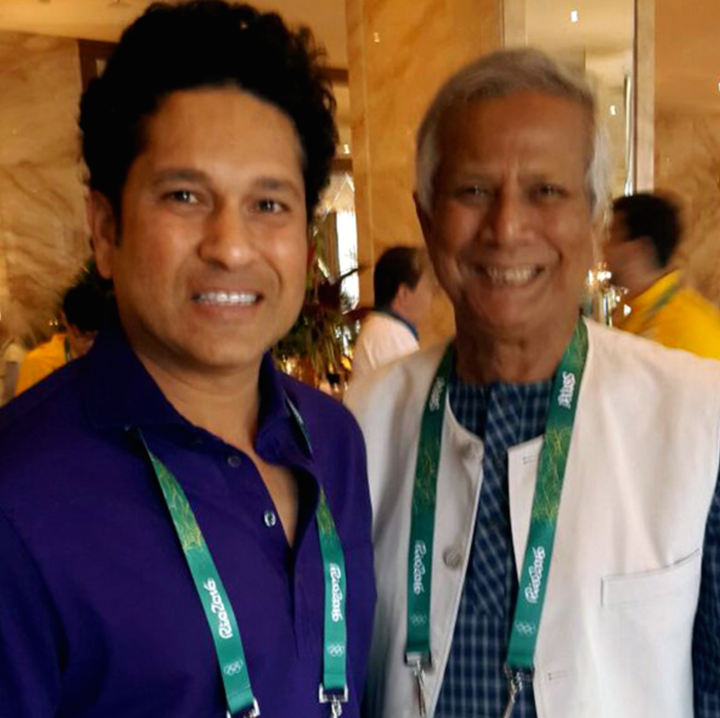
It was August 5, 2016. I was teaching Discrete Math for Computer Science at Princeton. In the middle of the class, one of my students asked, “Do you know Muhammad Yunus?” I did not know what to say and why the student asked me such a question. After all, I never told them that I was from Bangladesh.
“Did you see him bear the torch with Sachin Tendulkar at the Rio Olympics today?” the student added, full of excitement. I tried to hide my own excitement; after all, I had to cover the syllabus. But it all came back towards the end of the class, “Yes, I know Muhammad Yunus, who is the first person since Nelson Mandela to achieve the trifecta: Nobel Peace Prize, the US Presidential Medal, and the US Congressional Medal. I will tell you his story in four parts: (1) Yunus role in 1971 (2) Microcredit & Social Business (3) Grameen Bank and (4) Trial of Yunus.
Role of Yunus in 1971:
Yunus was born in 1940 in East Bengal (now Bangladesh) in what was then British India. Several major developments altered the framework of the South Asian sub-continent within the first seven years after Yunus was born. The year 1947, in fact, opened with the end of British Empire, which led to the creation of India and Pakistan. Although East Bengal was culturally and ethnolinguistically tied with India; geographically it became the eastern wing of Pakistan—a state based on Islam. Bengali politicians had assumed that the East would emerge as an economic power as a result of identical religion. However, these dreams were short-lived. In fact, it became a nightmare when West Pakistan unofficially imposed economic discrimination against its East wing. The destructive consequences for Bengalis were severe socially, politically, economically, and psychologically. Nationalism emerged as a tool to deal with segregation and Shack Mujibur Rahman became its leader. Bengalis deeply despised discrimination and were willing to take great risks to gain independence. This nationalist spirit was given high visibility in the Bengali nationalist revolt led by Mujib during the 6th decade of twentieth century. Mujib was arrested on March 26 and flown to West Pakistan for trial. Meanwhile, Major Ziaur Rahman, an army officer, proclaimed the independence of Bangladesh on behalf of Mujib. Then war broke out. Many organizations formed outside Bangladesh to support the war. Unity as a people and pride in the Bengali heritage led to the creation of the “Bangladesh Citizen Committee” in United States, led by Yunus, who was then teaching economics (i.e., from 1969 to 1972) at Middle Tennessee State University. Over the next few months, he wrote articles in newspapers, appeared on American television, and arranged a demonstration in front of Capital Hill to promote the war of independence with an international angle. Like Marx, Yunus then turned to journalism, and for a while, he was the editor of Bangladesh News Letter, which he regularly published from his Nashville apartment. Yunus’ article against Pakistani genocide was widely lauded in the Bengali community as well as in mainstream newspapers. Yunus was also involved in organizing a major charity concert, The Concert for Bangladesh, with George Harrison, Ravi Shankar, and Bob Dylan, on August 1, 1971 in Madison Square Garden, which caught worldwide attention regarding the Pakistani genocide in Bangladesh. He followed with increasingly more radical articles throughout the war, from August 1971 to January 1972, producing a 10-part series on empowering oppressed Bengalis. His prophecy inspired Bengali-Americans, and this positive response to the articles served to increase paper circulation. Soon, his apartment became the hub of the North American-based Bengali nationalist movement. Just as the fledgling U.S owed its final victory to the timely military intervention of France at Yorktown, so did Bangladeshi independence came about as soon as it did because of the swift and successful campaign against West Pakistan from India, Europe, and the USA. However, the Bengali freedom fighters gave more than anybody else, in the form of their lives in staggering numbers, to make a reality of the long cherished dream of Amar Sonar Bengla (golden Bangladesh). Finally, the state of Bangladesh was born at the end of a nine-month liberation struggle, in which more than 3 million Bengalis died at the hands of the Pakistan army. This was the 16th of December 1971.
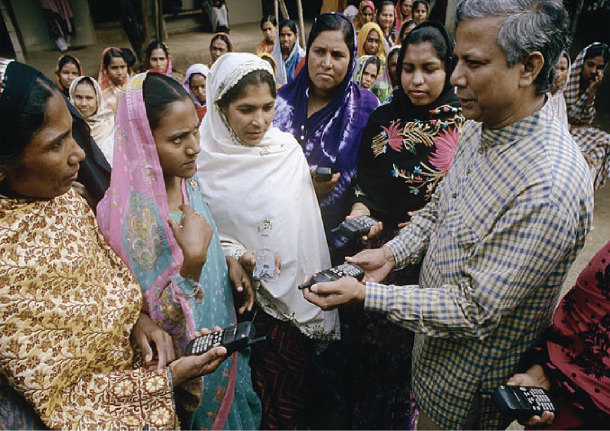
Microcredit and Social Business Model:
Meanwhile, Yunus was caught up in the euphoria of nationalism: his country fought against Pakistan to become a state based on equality, justice, and social harmony, echoing the sentiments dear to the heart of every Bengali. Now, it was no longer ruled by British or Pakistani dictators, but by its own people. This was why Yunus returned home: to join his countrymen who had been working tirelessly to rebuild the nation. However, by then, the country’s economic structure was on the verge of collapse. Its labor force grows by 2.4 percent annually but whose agriculture, industry and service sectors can accommodate an annual growth rate of only 1.2 percent. It is worth noting that agriculture was the biggest economic sector, which itself supplied more than 80 percent of the rural employment. Intending to address these issues, Yunus joined as a head of the economics department at Chittagong University, which was located in the southeastern edge of the country. However, by then, the country had already been caught up in famine, resulting from years of segregation and the 1971 Liberation War.
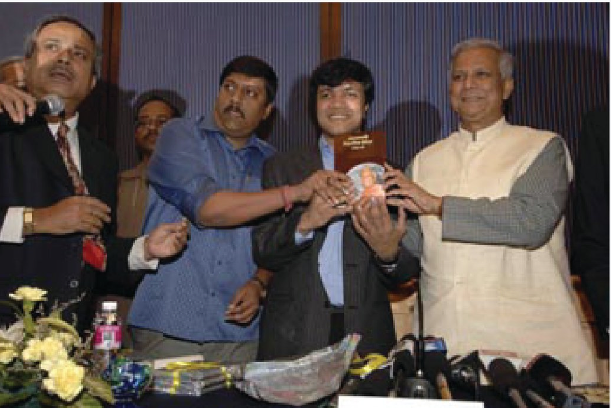
Upon witnessing such hungry people, Yunus lost his interest in the abstraction of classroom economics. He understood that poverty was the root cause of starvation, which led to many people’s deaths. However, what he did not understand was why millions became such vulnerable prey. Why was a tiny baby allowed to die for lack of food in this world of plenty? Hence, he started doubting all the well-designed economic theories. “...what good were all my complex theories when people were dying of starvation on the sidewalk and porches across from my lecture hall?” Yunus felt an increasing urgency to help these deprived people. He eventually abandoned these theories because nothing in them had a pledge for poor people. As a result, he went to Jobra, a remote village close to his university campus, to examine the real economics of a poor person’s existence, in the belief that he would find the cure for poverty if he studied it from a close distance. He conducted a survey to find out the real causes of poverty and found out that many villagers made their livings by rickshaw driving, bamboo weaving, and threshing newly cut rice with their feet. However, threshing newly cut rice only lasted during the harvest time. “How they survived rest of the year,” Yunus wrote, “most of them were not begging—so they must have done something”. At first, Yunus was not sure how could he help the landless poor people, especially during the time when there was no agricultural work. Meanwhile, the famine became even more devastating. Yunus was only in his 30s but already disillusioned by the situation.The famine dragged on and on. The worse it became, the more aggregated Yunus grew. Unable to stand it any longer, Yunus decided to visit the poorest households in Jobra to see if he could help them in any way. One day, as he was making his rounds in Jobra, he met with a woman named Sofia Katun, who was trying to make a living by constructing bamboo stools. Upon talking with her, Yunus learned that Sofia earned 4 takas ($0.02) a day, and she did not have enough cash (30 takas) necessary to purchase raw materials in order to make stools. As a result, she had to go to a trader, who purchased her final products, to borrow this money. However, the price the trader paid for Sofia’s final products barely covered the money she borrowed from him. Therefore, she ended up earning 4 takas a day. Although she knew that her life was a form of slavery; nevertheless, she could not break free because she was lacking the cash to buy raw materials. Traditionally, the usurious interest rates charged to borrowers have been accepted by society. “Usually, the borrower will have to borrow again, just to repay the prior loan and will ultimately wind up in a cycle of poverty like Sofia. It seemed to me that Sofia’s status as a bonded slave would only change if she could find that 30 taka to buy row materials”. At first, Yunus reached into his pocket to give her 30 taka, but finally, he decided not to charity her. Yunus also understood that donating Sofia 30 takas was not a solution to the problem on any permanent basis. “Credit could bring her the money.

She could then sell her products in a free market and charge the full retail price to the consumer.” Meanwhile, Sofia showed her reluctance to prolong her conversation with Yunus. Instead, she started squatting barefoot on the hard mud. Upon finding the crisis much more severe than he had expected, Yunus fell into deep thought. “How would Sofia’s children go to school when the income she earned was barely enough to buy food? It seemed hopeless to imagine that her babies would one day escape this misery”. Although at that point, Yunus was not sure whether poor people would pay back loans, he decided to experiment anyway. He strongly believed that the poor people would not abuse the loan because they needed it not only to escape from the burden of usurious, but also to escape from the burden of poverty for good. However, poor people do not know magic that would allow them to rise from their impoverished roots to break the cycle of poverty. Hence, they deserve effective tools and skills. Yunus founded Grameen Bank (GB) to provide these types of tools (e.g., means of production).There are actually two theories to explain the influence of GB: (1) microcredit, an innovative idea to spur entrepreneurship in poor people, formulated in 1974; and (2) Social Business (SB), a visionary new dimension for capitalism, in 1981. In my book, Grameen Social Business Model, I explain how these two concepts have gone from being theories to become an inspiring practice adopted by leading entrepreneurs (e.g., Bill Gates) and corporations (e.g., Danone) across the globe. Through GB, Yunus demonstrated how microcredit and SB can harness the entrepreneurial spirit to empower poor women and alleviate their poverty. One of the conclusions of Yunus’ concepts is that the poor are like a “bonsai tree,” and they can do big things if they get access to the SB that holds the potential to redeem the failed promise of free-market enterprise. Nicholas Kristof’s sound deductive argument proves the point, “Microcredit is undoubtedly the most visible innovation in anti-poverty policy in the last half-century. In the three decades since Yunus gave his first loan to a group of Bangladeshi women, the number of microcredit borrowers has crossed 150 millions”.
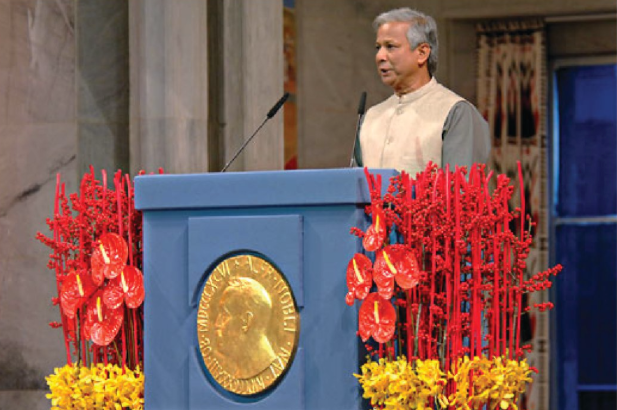
The Rise of Grameen Bank :
Yunus had pioneered the idea of social business (e.g., microcredit) into a banking system (i.e., Grameen Bank). By doing so, he created an opportunity to empower poor people’s lives, which led to the rise of the proletariat. Microcredit empowers women by putting capital in their hands and allowing them to earn an independent income and contribute financially to their households. Early on, Yunus realized that, in order to provide microcredit to poor people at a low interest rate, he would have to make his organizational cost very low. It was crucial, Yunus believed, to save workers time by housing them within the office. Grameen now has more than 2,384 branches operating in 83,458 villages. A Grameen branch is usually a two-story building made of concrete, which is identical to shelter to that helping poor people during heavy storms. The offices are located on the ground floor and dormitories are on the second floor. It is mandatory for employees to live in dormitory. (Yunus himself still lives in a dormitory located at the Grameen Bavan, Mirpur).
The Grameen system pays a lot of attention to monitoring the education of the children, housing, sanitation, access to clean drinking water, and their coping capacity for meeting disasters and emergency situations. In 1984, Grameen began offering housing loans to its borrowers. These loans helped build more than half a million houses for borrowers. In order to empower women, Grameen always gives the respective house ownership to the woman. Grameen also promotes education by providing some 30,000 scholarships a year to the children of its borrowers. It also provides student loans to help complete higher education.
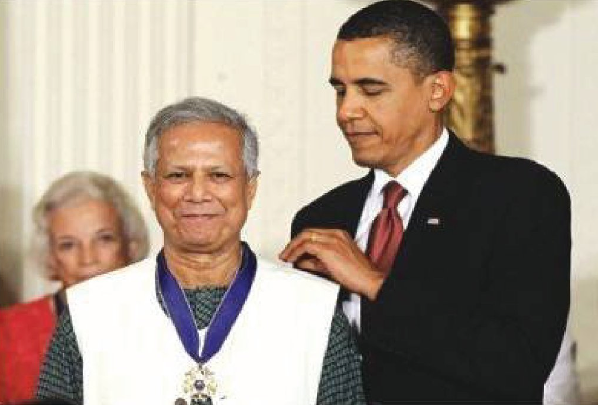
Grameen is more than a bank—it is a revolution. It is a force that tears down the wall of poverty by improving poor people’s social, political, and economic conditions. As a result, conditions among the poor people of Bangladesh have gradually improved since 1983. It is no coincidence that Bangladesh has also made dramatic progress in human development during the Grameen Revolution. Between 1980 and 2004, the Human Development Index increased by 45 percent in Bangladesh compared to 39 percent in India and 16 percent in Sri Lanka, even though per capita income in 2004 was 68 percent higher in India and over 200 percent higher in Sri Lanka.
Inspired by the Grameen Bank success, driven by the social objective, and lured by the poor people’s honesty, Yunus began to expand Grameen Social Business (GSB), slowly but gradually. Today, after 32 years of GSB experimentation, Yunus helps poor people to break the cycle of poverty through twenty-five organizations, each similar to Grameen Bank. These twenty five GSBs are often described collectively known as “the Grameen Family of Organizations”. These Grameen organizations, particularly Grameen Bank (GB), are amazing collections of social business activities dedicated to improve poor people’s lives, especially poor women. The story behind each of these organizations reveals the gradual emergence of the social business-concept to serve society and improve the lot of poor. However, what is the magic that Grameen Bank has applied to create a social business empire?
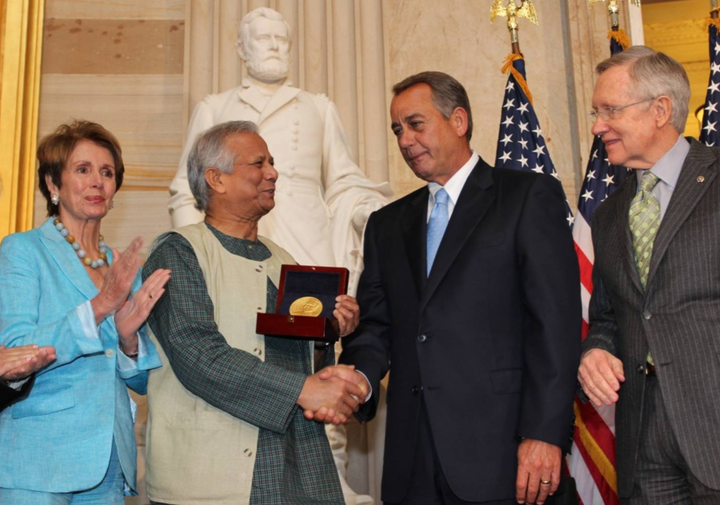
Trial of Yunus:
Prime Minister Hasina launched the first trial against Yunus in December 2010, one month after the release of Caught in Micro Debt, a documentary by Tom Heinemann. Screened on Norwegian television on November 30, 2010, the film broadcasted the allegation that Yunus stashed approximately $100 million in 1996 into Grameen Kalyan, a sister company of Grameen Bank. After completing a full investigation, the Norwegian government found Yunus innocent. However, Hasina used the situation as an excuse to increase a sustained attack on Yunus. She fired him from Grameen Bank, citing that he was older than the mandatory retirement age of 60, even though nine of the bank’s directors—who were elected by 8.3 million Grameen Bank borrowers—allowed him to stay on the job after he had crossed that threshold. Many people thought the prime minister would not take further damaging action against Bangladesh’s only Nobel Laureate, yet she continued her assault on Yunus and Grameen Bank. She brought more pressure against Grameen Bank by reducing the power of the bank’s directors and breaking the bank into nineteen pieces. However, in September 2013, her mission to destroy Yunus took an even more drastic turn: She decided to put him on trial again. Yunus has challenged the allegations against him and has claimed that they are baseless, politically motivated charges.
Yunus not only founded Grameen Bank but also nurtured it with his world-acclaimed, highly influential concepts of microcredit and social business. Yunus formulated microcredit in 1974 as an innovative idea to spur entrepreneurship among underprivileged people. Yunus believes that people who are poor can achieve success if they have access to microcredit. That does not mean that microcredit is the perfect remedy to end all poverty; however, it seems to be the best option available. In a sense, microcredit is like education; one can succeed only if he or she puts in the extra effort. Simply building more schools in remote villages will not educate everyone. By the same token, Grameen Bank does not turn everyone into a successful person. Yet a microcredit loan may indeed increase an individual’s chances of rising out of poverty. For example, Taslima Begum, who lives in Shibganj Upazila, took out a loan worth Tk 1,500 from Grameen Bank in 1991 to help her husband run a mechanic’s shop. The couple are now self-reliant. Begum received the Nobel Peace Prize on behalf of Grameen Bank from the chairman of the Norwegian Nobel Peace Prize Committee, Ole Danbolt Mjoes, at Oslo City Hall on December 10, 2006. Begum was merely 1 of 8.3 million borrowers; thus, we get a sense of how Grameen Bank successfully empowers women.
Yunus and Grameen Bank’s 8.3 million borrowers became a family. For the last three decades, they worked together, prayed together, struggled together, attacked poverty together, and even won the Nobel Peace Prize together. Hence, Yunus refused to allow Prime Minister Hasina to break Grameen into nineteen pieces. There are three factors contributed to her brash decision: the Nobel Peace Prize, hingsha, and politics.
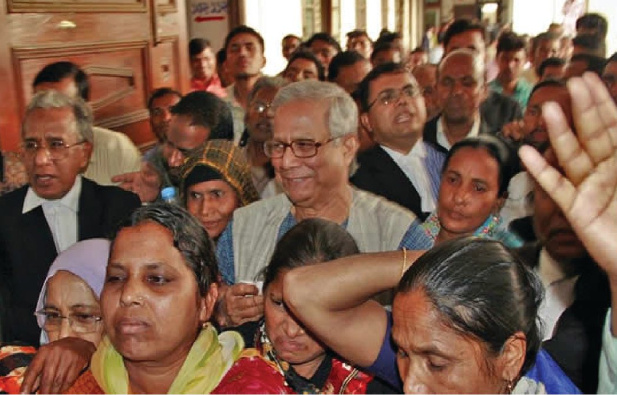
First, Prime Minister Hasina did not agree with Yunus winning the Nobel Peace Prize; she thought that the Norwegian Nobel Peace Prize Committee would award it to her for signing a peace treaty, the Chittagong Hill Tracts (CHT), in 1997. Second, Hasina experienced hingsha, which is a Bangladeshi word meaning jealousy or hatred. As Yunus won more awards and became more famous, Hasina feared his reputation would soar above that of her father, Shikh Mujib. Third, in an interview with the AFP news agency in 2007, Yunus remarked that politicians in Bangladesh work only for money, saying, “There is no ideology here.” In 2013, he decided to join in cleaning up corruption by launching a new political party, Citizen Power. However, he never went through with his plans.
Yunus is not a divine being or free from mistakes. Rather, he is a man, and no man in the world has never made mistakes. One does not have to be a Newton or Einstein to understand that the works of great people are tied to trials and tribulations. Every idea, invention, theory, and concepts has its own humiliating shortcomings, from Newton’s theory of gravity to Yunus’s theory of microcredit. Indeed, Yunus should have known better. Perhaps he should have done more for the poor people of the world or published more books. Instead, he became Prime Minister Hasina’s target for name-calling, accusations, and expulsion from Grameen Bank. President Obama remarked, “Professor Yunus was just trying to help a village called Jobra, but he somehow managed to change the whole world.” I hope Hillary Clinton, who will be the next President of the United States of America, does not have to continue reminding Prime Minister Hasina, like her predecessor Obama, to not break Grameen in 19 pieces.
Conclusion:
I end this story where I began, Rio, the biggest City in Brazil, where Yunus participated in the Olympic Torch Relay. As the torch relay moved out into poverty-stricken Campo Grande, one of the most unexpected torchbearers made an appearance: Muhammad Yunus. Microfinance has made a major contribution to the development of the Brazilian economy in recent years, especially in Campo Grande.
Only 150 years ago, slavery was thought to be an economic necessity. Abraham Lincoln freed the slaves through the Emancipation Proclamation some 148 years ago. Half a century ago, women were thought to be men’s property. Rosa Parks reversed the charge on December 01, 1955, in downtown Montgomery. Women have held up half the sky ever since. Only a few years ago, blacks were thought to be inferior to whites. Even US constitution segregated blacks by adding the clause”...three-fifths of all other Persons...” in the constitution. Dr. King proved the accusation wrong. With the same passion, many people still think that the poor are lazy and lacking in self-reliance, thus unable to escape from poverty. Yunus proved them wrong through the Grameen social business revolution.
Yunus, in fact, had been schooled in a tradition of Lincoln, Rosa Parks, and Dr. King. In the way that later generations quite rightly admired Lincoln, Rosa Parks, and Dr. King as symbols of revolt against dogmatism and arrogance, future generations will admire Yunus for the same reasons. We already saw some signs of admiration: he was chosen by Thomas Bach, president of the International Olympic Committee (IOC), to join the mission of spreading the spirit of the Rio 2016 Olympic Games throughout the world. This is why Yunus might also be compared with Lincoln, Rosa Parks, and Dr. King. All of them played important roles in history, but in the view of the length of Yunus role and the shoddier condition of his birthplace, the success of his concept and organization, and the importance of his revolution, I believe that Yunus should not be ranked behind Lincoln, Rosa Parks, and Dr. King. Of greater importance, however, is the role Yunus played in formatting microcredit and the social business concept and in founding Grameen Bank. The inscription on Karl Marx’s tomb might be applied even more appropriately to Yunus’ Grameen Bank: Poor people―especially the poor women of all lands, let’s rise together.
